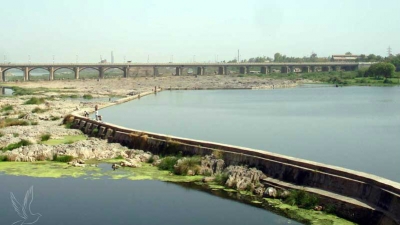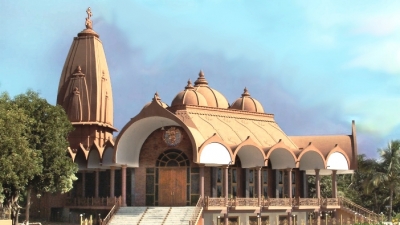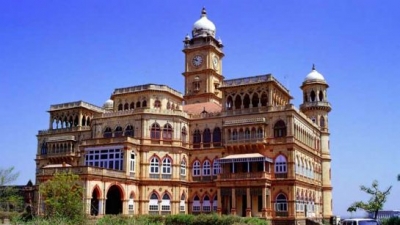Bhuj Attractions - Tourist Places To Visit In Bhuj
-
01Prag Mahal
+ Read MoreA beautiful Italian-Gothic Style building dating back to the 19th century, the Prag Mahal might seem familiar to many, as they pull in visitors, especially the Bollywood buffs. For the artistic manse has been used for shooting famous Hindi movies like 'Hum Dil De Chuke Sanam' and 'Lagaan' as well as various Gujarati flicks before.
However, the castle unfortunately remains in a despairing state today, all thanks to the 2001 earthquakes and a major burglary in 2006, when the thieves made away with many valuable artifacts from the place. However, it still remains open for public viewing and visitors can view the main palace hall and visit the bell tower from where they can enjoy a breathtaking view of the beautiful city. Prag Mahal was commissioned by King Rao Pragmalji II and constructed during the year 1865, for which a whooping 3.1 million rupees were spent back then.
-
02Hamirsar Lake
+ Read MoreNamed after the ruler of Jadeja, Rao Hamir, this man-made lake lies in the central area of Bhuj. With almost all the important sight-seeing destinations of Bhuj located to its eastern part, walking through the boundary of this 450-year-old lake could be fun. Present in the center of the water body is a colourful garden, which makes it look all the more attractive.
-
03Aina Mahal
+ Read MoreLocated in the Northeast corner of Hamirsar Lake in Bhuj, Aina Mahal or the 'Hall of Mirrors' is a wondrous edifice. Built during the mid-18th century and attractively designed by a dexterous artisan named Ram Singh Malam in a mixed Indo-European style, the Mahal houses some of the most beautiful art pieces and paintings.
Though the castle was almost destroyed during the 2001 earthquake, a part of the same, which remained quite intact, was restored and has been turned into a museum that is open for public viewing on all 365 days of the year.
-
04Kutch Museum
+ Read MoreThis one has almost everything that one would look for in a museum. From paintings to coins, musical instruments to artifacts and ancient script inscriptions to artistically etched sculptures. One of the oldest museums in Gujarat, located close by Hamirsar Lake, the depository came into existence during 1884 during the wedding of Maharo Khengarji III, in order to put some new art pieces on show. The Kutch museum is not just known to have the largest existing collection of the Kshatrapa inscriptions of the 1st century AD, but it also has various inscriptions of the non-existent Kutchi script. What's more, the museum also happens to be India's first ever museum to go online, which it did in the year 2010.
-
05Bharatiya Sanskriti Darshan
+ Read MoreA centre showcasing a wide range of Kutch folk arts and crafts, the Bharatiya Sanskriti Darshan is located on the college road. Open for public viewing on all days except Monday, the museum has a few rare pieces of art from the remote areas in Gujarat, most of them collected by a local forest service official.
-
06Swaminarayan Temple
+ Read MoreSituated close to the Ramkund Step-well, the Swaminarayan Temple in Bhuj has a beautiful surrounding. Around the place of worship are various colourful wooden sculptures of Lord Krishna and Radha, like they are present in the other Swaminarayan Temples in the country.
-
07The Black Hills (Kalo Dungar)
+ Read MoreA serene and mysterious place, the black hills lie about 25 km North of Khavda. The hills that also happen to be the highest point of Kutch provide a beautiful bird's eye-view of the Great Rann of Kutch. Present here is a 400-year-old Dattatreya Temple, which is a tourist attractor. But reaching the hills by public transport could be difficult, as only a single bus will ply from Khavda to Kalo Dungar during weekends. However, one can also hire jeeps to reach the hills.
Legends have it that when Lord Dattareya came down to earth, he found a flock of jackals starving out of hunger and touched by the helplessness of the animals, he fed himself as food to them. But even as they ate, his body continually regenerated itself. Hence, even to this day, the priest at the temple feeds a flock of jackals with rice after puja every evening. Since the hill lies close by the Pakistan Border, there is an army post beyond which only the military personnel are let in.
-
08Kutch Desert Wildlife Sanctuary
 + Read More
+ Read MoreThe entire area of this desert sanctuary is stunningly awesome. Declared a sanctuary in the year 1986, the enchanting Kutch Desert Wildlife Sanctuary supports a large variety of mammalian wildlife and rare species of birds.
Present in the Great Rann of Kutch, the place happens to be one of the largest seasonal saline wetlands with a water depth of about 0.5 and 1.5 metres. And during the months of October and November, the rain water here goes completely dry, thus turning the entire area of the sanctuary into a saline desert.
-
10Royal Chhatardis
+ Read MoreThe Royal Chhatardis must be one of the calmest hubs in Bhuj, though present very much within the town. Away from the busy roads and with no buildings in its vicinity, present here are the memorials of the Royals of Bhuj, with each monument being more attractive than the other. Though a few of them were destroyed during the 2001 earthquake at Bhuj, the monuments of Raydhanji II, Lakhpatji and Desarji still remain intact. The place is worth a visit.
-
11Ramkund Step-well
+ Read MoreDescend a few steps for serenity through this stair well, if you are anywhere close by the Kutch museum or the Ram Dhun Temple of Bhuj. While it would be great to spend a few minutes in the vicinity of the well, which is close to Ram Dhun, watching beautiful images of the characters of Ramayana and the ten incarnations of Lord Vishnu etched on a wall on one of its sides adds to its beauty.
-
12Bhujodi
+ Read MoreArt lovers will love this place. A little town about 8 km ahead of Bhuj, Bhujodi, is a unique town where most of the locals are artisans. It is the textile hub of Kutch, where one can come across many artisans, weavers and block printers. Located close to Bhujodi are the Ashapura Crafts Park and Shrujan – a non-profit organization, both of which provide the local artisans a chance to put their artworks on show. While the Ashapura Park is active with entertainment shows along with the expo during weekends, Shrujan campus includes a production centre and an exhibition.
-
13Dhamadka
+ Read MoreBhuj boasts of being home to various interesting towns famous for handicrafts and textiles. Dhamadka too is one such. A town that lies about 57 km away towards Bhuj's East, is a hub of artisans adroit in the attractive Ajrakh block printing technique.
-
14Kera
+ Read MoreKera, which is about 22 km away from Bhuj towards its South consists of a shrine of Lord Shiva of the Solanki rulers' era. While a major part of the temple was destroyed during the 1819 earthquake, one-half of the temple, the sanctum sanctorum and the deity within still remain intact. Located next to it is the fort of Kapilkot, which also is in a dilapidated state now.
-
15Khavda
 + Read More
+ Read MoreIt is good to pay a visit to Khavda for various reasons. One can come across the India-Pakistan border about 30 km ahead of this last village of Kutch. It is famous for handicrafts, leather products and arty textiles by its local artisans and the hamlet is also the departure point to visit the world's largest flamingo colony where thousands of flamingos migrate every year.
The flamingo colony exists at a lake in the desert of Jamkundaliya, which received lakhs of winged visitors between the months of October and March every year. What makes a visit to the place all the more interesting is that the colony can be reached only on a camel's back.



 Click it and Unblock the Notifications
Click it and Unblock the Notifications


















